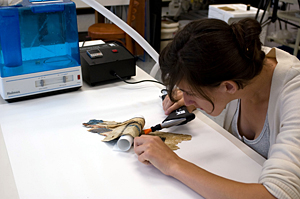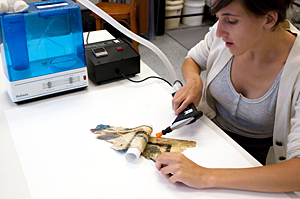
ADVERTISEMENT
- UD grad students help preserve cultural heritage across U.S., around globe
- LeeAnn Barnes Gordon: Agora Excavations, Athens, Greece
- Lauren Bradley: Walters Art Museum, Baltimore
- Alisha Chipman: Paul Messier, LLC
- Rose Daly: Nasher Sculpture Center, Dallas
- Emily MacDonald-Korth and Carlos Moya: Fengguo Temple, Yixian, China
- Amanda Maloney: C.C. von Waldthausen Fotorestauratie Atelier, Amsterdam
- Gwen Manthey: Western Center for the Conservation of Fine Arts, Denver
- Carrie Roberts: English Heritage, London
- Kirsten Travers: Stichting Restauratie Atelier Limburg, the Netherlands
- Renee Wolcott: Smithsonian National Portrait Gallery
- Erin A. Anderson: Poggio Colla, Mugello Valley of Tuscany
- Tatiana Cole: Metropolitan Museum of Art
- Anne Getts: Philadelphia Museum of Art
- Sarah Gowen and Stephanie Oman: Shangri La, Honolulu, Hawaii
- Allison Holcomb: Colonial Williamsburg, Williamsburg, Va.
- Ellen Moody: Sherman Fairchild Center, Metropolitan Museum of Art
- Steve O'Banion: Smithsonian American Art Museum, Lunder Conservation Center
- Ellen Promise: Philadelphia Museum of Art
12:02 p.m., July 28, 2010----I arrived at Colonial Williamsburg in the beginning of June to spend time in the paper conservation lab working on their study collection of wallpaper fragments. One of my first projects dealt with two fragments from a house in Charleston. A powdery green pigment on them prompted me to do some research on pigments used during the time period. Finding that Paris green (emerald green, or Scheele's green), which contains arsenic, was a commonly used pigment especially in wallpaper at the end of the 18th century for its brighter, more vibrant color meant that caution and further testing were necessary.
Using X-ray fluorescence spectroscopy (XRF) in the form of a futuristic hand-held device, I was able to confirm the presence of arsenic in those fragments and rapidly test all of the wallpaper in the collection. There were plenty of examples of Paris green and a number of interesting anomalies to be found in the process: in three instances, a uniform coverage of arsenic on the fragments pointed to its use as a pesticide rather than a pigment. Those fragments that contained arsenic were re-housed in custom polyester enclosures and were well marked to reduce risk in future handling.
As I continue to look at the data acquired with XRF it should provide an interesting glimpse of what green pigments were prevalent in wallpaper during the collection's time period and how they were used.
In addition to wading through toxic elements, I have had the chance to continue a project begun in my cross-section microscopy class last fall on fragments taken from Brandy, a house in Anne Arundel County, Md., that was demolished in the 1980s. With cross-section analysis, I found three generations of wallpaper dating back to 1789 interleaved with contemporary newsprint and handwritten letters, and bound together with wheat-starch paste.
In the lab at Colonial Williamsburg with the supervision of paper conservator Pam Young, the papers have been carefully documented and separated with humidification revealing a hitherto unsuspected hand-colored wood engraving pasted to the first generation.



